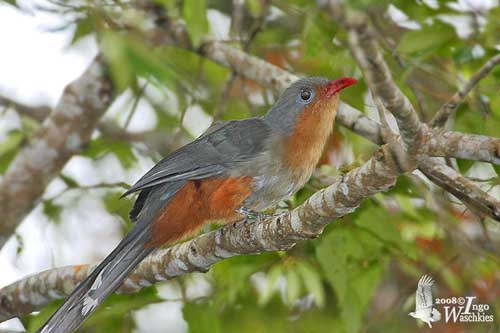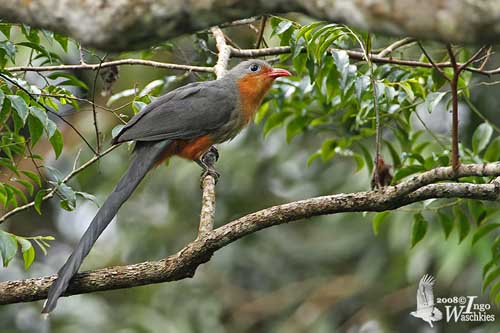
Fr: Malcoha javanais
All : Kastanienbauchkuckuck
Esp: Malcoha Piquirrojo
Ital: Malcoha beccorosso
Nd: Roodsnavelmalkoha
Sd: Rödnäbbad malkoha
Photographer:
Ingo Waschkies
Bird Photography
Text by Nicole Bouglouan
Sources:
HANDBOOK OF THE BIRDS OF THE WORLD vol 4 by Josep del Hoyo-Andrew Elliott-Jordi Sargatal - Lynx Edicions - ISBN: 8487334229
A Field Guide to the Birds of South-East Asia by Craig Robson. New Holland Publishers. ISBN: 9781780090498
BirdLife International (BirdLife International)
Malaysian Birds - Birds’ photos, videos, bird calls & information by Khong Tuck Khoon
Red-billed Malkoha
Zanclostomus javanicus
Cuculiforme Order – Cuculidae Family
BIOMETRICS:
Length: 42 cm
Weight: 98 g
DESCRIPTION:
The Red-billed Malkoha belongs to the subfamily Phaenicophaeinae, within the Cuculidae family. This species is now included in the genus Zanclostomus.
The adult has grey upperparts, with bluish-green gloss on back and wings. The grey, graduated tail is tipped white.
The underparts are rufous with broad grey lower breast bar.
On the head, forehead, crown and nape are grey, whereas lores, chin, throat and cheeks are rufous.
The bill is red with blackish culmen. The eyes are dark brown, surrounded by bare grey or blue eyering. Legs and feet are slaty-grey.
Both sexes are similar. The juvenile resembles adults, but it has narrower rectrices and shorter tail.

VOICE: SOUNDS BY XENO-CANTO
The Red-billed Malkoha utters hard, frog-like “uc uc uc uc uc uc…” ending sometimes in a faster “uc-uc-uc…”
We can also hear a quiet, deep “kuk”
HABITAT:
The Red-billed Malkoha is a forest species. It frequent broadleaved evergreen forest where it occurs mainly high in trees, forest edge, secondary growth and scrub. This species is visible from lowlands and hills up to 1000-1200 metres of elevation, sometimes up to 1500 metres.
RANGE:
The Red-billed Malkoha is resident in its range in S Myanmar and S Thailand, through Peninsular Malaysia to Sumatra, Natuna Islands, Borneo and Java.
BEHAVIOUR:
The Red-billed Malkoha feeds mainly on large insects such as cicadas, stick insects (Phasmids), grasshoppers, mantids, beetles, bugs, flying termites, caterpillars and Pieridae pupae. It also takes spiders and crustaceans. These are typical preys of forest cuckoos.
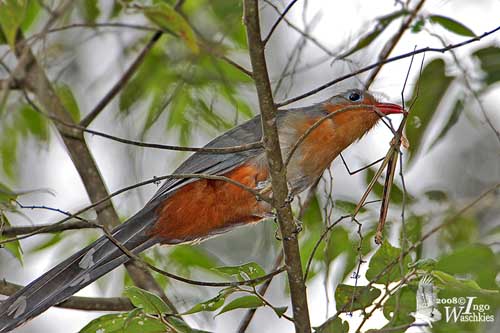
Arboreal species such as the Red-billed Malkoha often hunt by ambush. The bird remains motionless on a perch. Once the prey is detected, it flies towards it and grasps the prey before to return to its perch.
Caterpillars are often cleaned in order to remove the toxic leaf products which fill the gut. The caterpillar is often beaten repeatedly against a branch, as well to remove the gut contents, as sometimes the hairs too, before to swallow it. But the hairs can be regurgitated in a pellet by the malkoha.
The Red-billed Malkoha feeds by moving through the vegetation with hops, and balancing or twisting the long tail like squirrels, and then, turning and catching a prey. It is more active in the morning and early afternoon.
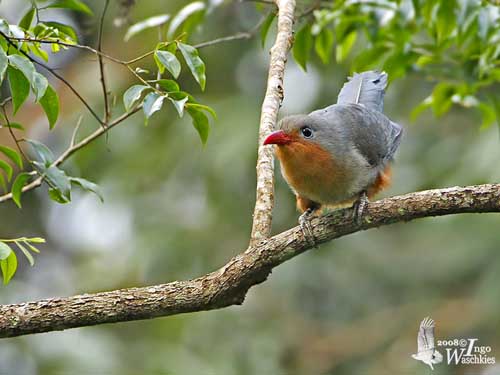
The Red-billed Malkoha is a nest-building species, and does not parasitize other nests. Courtship displays are poorly known, but the male spreads and raises its tail in order to enhance the white tips of rectrices. Head pattern such as red bill and blue eyering are probably exposed during displays.
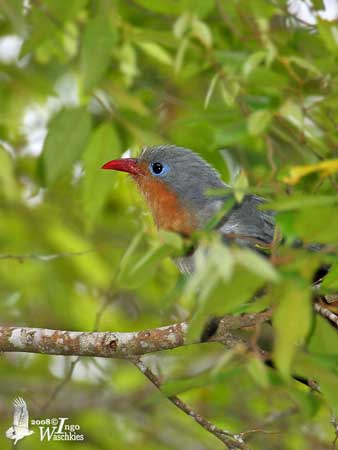
FLIGHT:
The Red-billed Malkoha, as a short-winged tropical forest species, performs mainly gliding flight over short distance, usually from branch to branch. The flight is slow but the wings may produce a soft hum while the bird is gliding. It is not a strong flier.
REPRODUCTION:
The breeding season takes place between May and July.
The Red-billed Malkoha is monogamous, and male and female live in social pairing.
The nest is placed in bush. This is a flimsy, shallow platform made with twigs and leaves.
The female lays two chalky-white eggs. Both parents share all the nesting duties. Usually, the chicks leave the nest before to be able to fly, but they learn very soon how to creep along branches.
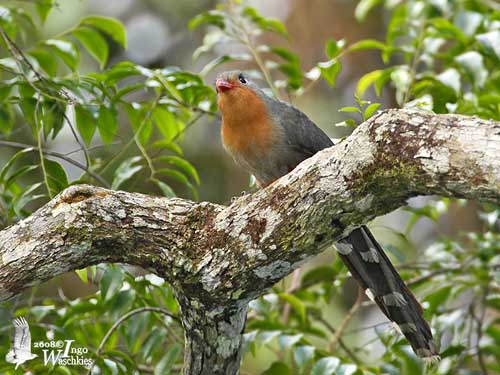
DIET:
The Red-billed Malkoha feeds on large insects of several species, including hairy caterpillars usually avoided by other birds. It also takes spiders and crustaceans. It regurgitates indigestible parts in a pellet.
PROTECTION / THREATS / STATUS:
The Red-billed Malkoha is a common species in Borneo where this bird has adapted to changes in its habitat. It is less common in Java and Sumatra, and rare in Myanmar.
This species is not currently threatened.
